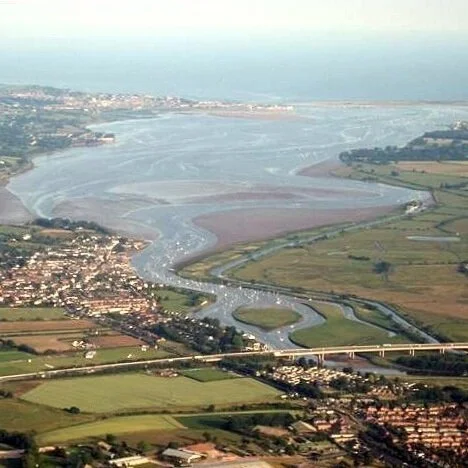Week 7: Burton Bradstock to Durdle Door
As the Cameron Peak Fire continues to burn (and the air quality here continues to be poor), my virtual run from Land’s End to John O’Groats continues to be a virtual row. And for this week’s leg of the journey, rowing is appropriate, as the stretch from Burton Bradstock to Durdle Door tracks along Dorset’s Jurassic Coast, some of the most stunning coastal scenery on Earth… at least if the photos I’m finding on Google are any indication!
On Monday, I passed Hive Beach, the first scenic stop of this week’s segment. And it seems I passed by just in time, because as I write today (Sunday) the BBC informs me there was a huge cliff collapse there yesterday! Fortunately, it appears that no one was hurt or killed in the collapse, but such calamities aren’t unheard-of in the region. It is suspected that recent heavy rain had saturated the soils and made the cliffs unstable.
Photo of the Hive Beach cliff collapse by Cynthia Justham, who had been walking there that morning.
Beyond Hive Beach, after passing through the tiny villages of Swyre, West Bexington and East Bexington, I came upon Abbotsbury Subtropical Gardens. Like many sites in this region, its origins date back to Abbotsbury Abbey, a Benedictine monastery founded in the eleventh century by Orc and his wife, Tola. Orc was a thegn (which sounds like an early equivalent of a vassal) of King Cnut. The gardens are on a site that used to be a vegetable garden to feed people at the monastery (and later, the manor houses that were built nearby).
The range of plants in the garden expanded during the 19th century under the auspices of William Fox-Strangways, 4th Earl of Ilchester. A diplomat and botanist, he brought plant specimens back from his travels around the world, including Citronella mucronata from Chile, Picconia excelsa, which is an endangered species from the Canary Isles, and the genus Stranvaesia which named after him (now known as Photinia) from southeast Asia. By the 20th century, the garden had become a tourist attraction.
Abbotsbury Subtropical Gardens, just west of the town of Abbotsbury.
A bit further down the road from the gardens is the Abbotsbury Swannery, which was established around 1040 to raise mute swans so that the monks could serve them for dinner at their lavish feasts. Today, mute swans are protected as wild birds under the 1981 Wildlife and Countryside Act, so it is illegal to kill them (thank goodness!) and the Abbotsbury Swannery is now a wildlife refuge rather than a feedlot. In addition to being a great place to watch swans, many other birds can be spotted here, as birdwatcher Steve Groves documents in his blog, Steve’s Swannery Sightings.
Birds at the Abbotsbury Swannery.
Also: remember the scenes in Harry Potter and the Half-Blood Prince when Harry is transported back to the Burrow, which is surrounded by vast swaths of reedy vegetation? The vegetation was filmed around the Abbotsbury Swannery. (Apparently the lead actors were not a part of that filming, so the scene must have been created using green screens, composite shots and other movie magic.)
Down the coast from Abbotsbury, the Isle of Portland (or as they call it, the “tied” isle of Portland, given that it is tethered to the mainland by a narrow strip of beach) points south into the Channel. It is the southernmost point in Dorset. Nearby Portland Harbor has been used as a landing-place since the mesolithic era. Vikings landed here in 789, and William II built Rufus Castle (now ruins) sometime after his father, William the Conqueror, came ashore in 1066. Other fortifications were built by Richard, Duke of York in the fifteenth century, and by Henry VIII in the sixteenth century. So to say it’s a historic area is an understatement!
After serving as a naval base for the Royal Navy and NATO for centuries, Portland transitioned into a civilian harbor in 1995, and is now a commercial port and tourism site.
And finally, the last scenic stop this week is Durdle Door, an icon of the Jurassic Coast. It is a natural arch, formed from a layer of hard limestone standing almost vertically out of the sea. What a beautiful spot to end the week!
Dorset icon Durdle Door.
Fancy a Pint?
Unlike the Naylor brothers, who pledged to “abstain from all intoxicating drink” during their 1871 walk on this route, I’m not at all opposed to popping into interesting-looking pubs along the way. Here are a few along this stretch of the journey:
The Brewers Arms, Martinstown
In Martinstown, up the hill from the Jurassic Coast I followed all week, is the Brewers Arms, a classic country pub. The building was constructed in 1848 and converted into the village inn in 1865, when the beer served in the pub came from the Brewery House across the street. In the early years, the pub was particularly popular with farmers washing their sheep in the washing pool just up the lane in front of the pub. The washing pool is still there and now acts as the starting point for the annual Duck Race which sees hundred of plastic ducks “racing” each other down the stream.
The Elm Tree Inn, which bills itself as “a place for walkers, wanderers and wonderers,” dates from the mid-17th century. Once upon a time, the inn was frequented by “smugglers and wreckers.” In more recent decades it was visited by scientist and inventor Sir Barnes Neville Wallis and Sir Winston Churchill during the Second World War. It was even a secret rendezvous for Russian spies during the 1960s; Harry Houghton and his girlfriend Ethel Gee used the Elm Tree to rendezvous with their KGB “controller” in what became know as the Portland Spy Ring.
Houghton would come to the pub and await phone calls from his KGB masters on certain nights, before disappearing to spy on the nuclear submarine fleet based at Portland.
We can also add the Elm Tree Inn to our running list of pubs that are said to be haunted.
The Elm Tree Inn, Langton Herring
The Smugglers Inn, outside Osmington
Just outside Osmington, on the cliff tops of the South West Coast Path, the Smugglers Inn is a traditional English pub with stunning views overlooking the Isle of Portland.
The headquarters of the French smuggler Pierre Latour and one of the main landing places for smuggled goods in the 17th century, the Inn was originally built in the 13th century, with its own brewery at the rear.
In 2016, Hall & Woodhouse spent £250k to shore up the walls of the small stream that runs in front of the pub, which involved diverting it for four months. The pub advertises that “because of coastal erosion, there’s a good chance the Smugglers won’t be with us by 2068, so enjoy it while you can!”
Sustenance for the Hungry Vegan
The Nautico Lounge, in Weymouth, offers an all-vegan menu in a fun, festive setting. The restaurant is in a really handsome old Post Office building in the heart of town, and includes a great little garden out the back, so you should have no problem finding a spot to call your own and relaxing. The decor includes, as they say, “buckets of old pictures and tremendously dangly tassel-y lightshades.” So any hungry vegan would be sure to find sustenance here!
The Nautico Lounge in Weymouth
Outdoor seating at Billy Winters Bar and Diner.
On Portland Beach (part of the beachy peninsula that connects the Isle of Portland to the mainland, making it a “tied” island) sits Billy Winters Bar and Diner. The building had its first life as a shipping container, and has since been renovated and expanded into a restaurant. Though not a vegan-only restaurant, the menu offers lots of vegan options including the ability to substitute vegan cheese onto any pizza. Their beet burger (sounds odd, I know, but give it a try) was raved about in many online reviews.
Finally, even though the Jailhouse Cafe isn’t particularly vegan friendly, I want to shine a light on the good rehabilitative work it is doing. The cafe is in part staffed by inmates from a prison about a mile away, so that prisoners can gain useful skills and work experience prior to full release back into the community. Chef Paula Marfell leads the effort, training prisoners to prepare delicious dishes in compliance with health and safety regulations. The cafe’s contribution in helping offenders get back into society is “priceless” according to Martyn Underhill, the Crime Commissioner for Dorset. Since the US seems to value punishment over rehabilitation in our own criminal justice system, I was really struck by the Jailhouse Cafe’s enlightened approach.
View from the Jailhouse Cafe on Isle of Portland
















